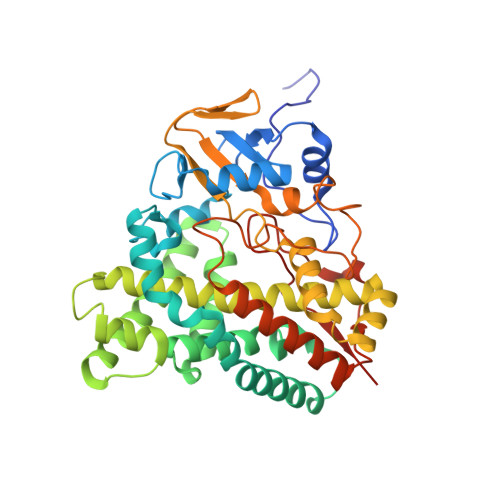Crystal Structure of CYP105A1 (P450SU-1) in Complex with 1alpha,25-Dihydroxyvitamin D3
Sugimoto, H., Shinkyo, R., Hayashi, K., Yoneda, S., Yamada, M., Kamakura, M., Ikushiro, S., Shiro, Y., Sakaki, T.(2008) Biochemistry 47: 4017-4027
- PubMed: 18314962
- DOI: https://doi.org/10.1021/bi7023767
- Primary Citation of Related Structures:
2ZBX, 2ZBY, 2ZBZ - PubMed Abstract:
Vitamin D 3 (VD 3), a prohormone in mammals, plays a crucial role in the maintenance of calcium and phosphorus concentrations in serum. Activation of VD 3 requires 25-hydroxylation in the liver and 1alpha-hydroxylation in the kidney by cytochrome P450 (CYP) enzymes. Bacterial CYP105A1 converts VD 3 into 1alpha,25-dihydroxyvitamin D 3 (1alpha,25(OH) 2D 3) in two independent reactions, despite its low sequence identity with mammalian enzymes (<21% identity). The present study determined the crystal structures of a highly active mutant (R84A) of CYP105A1 from Streptomyces griseolus in complex and not in complex with 1alpha,25(OH) 2D 3. The compound 1alpha,25(OH) 2D 3 is positioned 11 A from the iron atom along the I helix within the pocket. A similar binding mode is observed in the structure of the human CYP2R1-VD 3 complex, indicating a common substrate-binding mechanism for 25-hydroxylation. A comparison with the structure of wild-type CYP105A1 suggests that the loss of two hydrogen bonds in the R84A mutant increases the adaptability of the B' and F helices, creating a transient binding site. Further mutational analysis of the active site reveals that 25- and 1alpha-hydroxylations share residues that participate in these reactions. These results provide the structural basis for understanding the mechanism of the two-step hydroxylation that activates VD 3.
Organizational Affiliation:
RIKEN SPring-8 Center, Harima Institute, Sayo, Hyogo 679-5148, Japan. sugimoto@spring8.or.jp




















